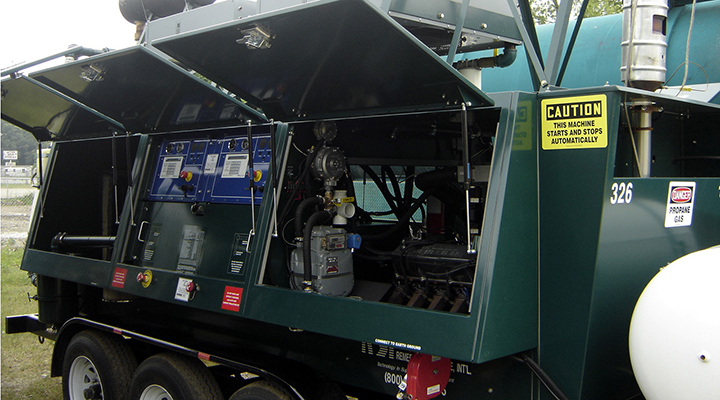Internal Combustion Engine Systems (I.c.e)
See All Air & Water RemediationMobile and emergency internal combustion engine systems for treating high concentrations of hydrocarbon vapor. Features a DRE (Destruction Rate Efficiency) >99%
- is the minimum order quantity for this product. Please check quantity and add to cart again.

Mobile and emergency internal combustion engine systems for treating high concentrations of hydrocarbon vapor. Features a DRE (Destruction Rate Efficiency) >99%
Description
"Mobile and emergency internal combustion engine systems for treating high concentrations of hydrocarbon vapors. Because our ICE systems run on propane, site power is not required.
After the initial start-up on propane, the carburetor switches to run off of hydrocarbon vapors from the contaminant stream. The contaminants are combusted in the engine and emitted as CO2 and water. ICE systems are safe and have the unique feature of automatically removing water from the moisture separator. This feature allows unattended operation in situations where the vapor stream is saturated with water.
In remediation applications, the systems are designed with a knock-out tank with particulate filter, flame arrestors, vacuum and pressure gauges, and sample ports. The system utilizes a Phoenix 1,000 controller and contains on/off switches for all components, low oil/high temperature shut down, well valve control system and interlock connections. The control system will automatically adjust the dilution air, process flow and supplemental fuel valves to maximize process flow without sacrificing safety or effluent emissions quality.
In industrial applications, the vapor from Above Ground Storage Tanks (ASTs) and pipeline activities is usually contaminated with hazardous air pollutants (HAPs) such as volatile organic compounds (VOCs), nitrogen oxides (NOx), and carbon monoxide (CO). Waste air must meet air discharge requirements before discharge to the atmosphere. ICE units are used to meet these requirements.
Many ASTs have a roof that floats on the stored product. Any time there is vapor space under the floating roof, there is a risk for vapors to escape. During a fill, before the roof floats on the rising product, vapors are pushed up and out of the tank. Evoqua may use an ICE to treat these vapors. Depending on the fill rate and product in the tank, Evoqua will use the right size ICE to accommodate that rate to ensure compliance. ICE units have a great turn down ratio on auxiliary fuel consumption.
Pipeline Degassing using Internal Combustion Engines
Pipelines are another source of hazardous vapors. Pipeline degassing, cleaning, hydrotesting, decommissioning, and other activities may release contaminated gases. These must be captured and destroyed to protect human health and safety and the environment.
The vapor from ASTs and pipeline activities is usually contaminated with hazardous air pollutants (HAPs) such as volatile organic compounds (VOCs), nitrogen oxides (NOx), and carbon monoxide (CO). Waste air must meet air discharge requirements before discharge to the atmosphere. ICE units are used to meet these requirements.
Evoqua has a variety of safe ICE units, from 4-cylinder to dual 8-cylinder, available for long and short-term rental and offers complete turn-key services for projects as well. And because our ICE technicians are experts in the operation and maintenance of environmental remediation engines, they keep our engine systems in like-new condition.
Contact us to find out more and discuss the detail of your project!
Features
Types of Remediation
- Aboveground Storage Tanks
- Barge Degassing
- Centrifuge Vapor Control
- Land Remediation
- Pipeline Degassing & Vapor Control
- Railcar Degassing & Vapor Control
- Underground Storage Tanks
- Vacuum & Tanker Truck Vapor Control
